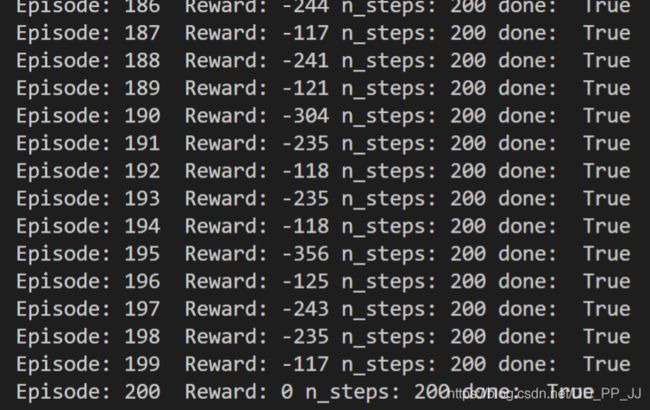【深度强化学习】8. DDPG算法及部分代码解析
【DataWhale打卡】DDPG算法 Deep Deterministric Policy Gradient
视频参考自:https://www.bilibili.com/video/BV1yv411i7xd?p=19
1、思维导图
2. 详解
DDPG是解决连续性控制问题的一个算法,但是和PPO不同,PPO输出是一个策略,是一个概率分布。而DDPG输出的是一个动作。
DDPG是采用的也是Actor-Critic架构,是基于DQN进行改进的。DQN中的action space必须是离散的,所以不能处理连续的动作空间的问题。DDPG在其基础上进行改动,引入了一个Actor Network,让一个网络来的输出来得到连续的动作空间。
| 对比 | AC | DDPG |
|---|---|---|
| Actor | 输出的是概率分布 | 输出是动作 |
| Critic | 预估V值 | 预估Q值 |
| 更新 | 带权重梯度更新 | 梯度上升 |
优化Q网络的时候,如果Q-target也在不停的变动,那就会造成更新困难。类似DQN,DDPG也采取了固定网络结构的方法,先冻结target网络,更新参数以后,再把参数赋值到target网络。所以需要的是四个网络:
- actor
- critic
- target actor
- target critic
通过上图可以看出,DDPG(也是一种Actor-Critic方法),其实也是一种时序差分的方法,结合了基于Value-based和Policy-Based方法。其中Policy是Actor,用于给出动作;价值函数是Critic,评价Actor给出的Action的好坏,产生时序差分信号用于指导价值函数和策略函数的更新。
3. 代码
代码主要看DDPG算法主要几个模块:
3.1 背景
DDPG这里要解决的问题是一个钟摆问题,Pendulum-v0。这个版本的问题中,钟摆以随机位置开始,目标是将其向上摆动,使其保持直立。这是一个连续控制的问题。
状态表示:
动作空间:
奖励评估:
− ( θ 2 + 0.1 ∗ θ d t 2 + 0.001 ∗ a c t i o n 2 ) -(\theta^2 + 0.1*\theta_{dt}^2 + 0.001*action^2) −(θ2+0.1∗θdt2+0.001∗action2)
可以看出,目标就是保持零角度,也就是垂直,同时要求旋转速度最小,力度最小。
3.2 Actor
Actor作用是接收状态描述,输出一个action,由于DDPG中的动作空间要求是连续的,所以使用了一个tanh
class Actor(nn.Module):
def __init__(self, n_obs, n_actions, hidden_size, init_w=3e-3):
super(Actor, self).__init__()
self.linear1 = nn.Linear(n_obs, hidden_size)
self.linear2 = nn.Linear(hidden_size, hidden_size)
self.linear3 = nn.Linear(hidden_size, n_actions)
self.linear3.weight.data.uniform_(-init_w, init_w)
self.linear3.bias.data.uniform_(-init_w, init_w)
def forward(self, x):
x = F.relu(self.linear1(x))
x = F.relu(self.linear2(x))
x = F.tanh(self.linear3(x))
return x
实现方面,就是用了几个全连接层来设计的网络,输出的结果是一个连续的值。
3.3 Critic
Critic批评者,在DDPG中,接受来自Actor的一个Action值和当前的状态,输出的是当前状态下,采用Action动作以后得到的关于Q的期望。
class Critic(nn.Module):
def __init__(self, n_obs, n_actions, hidden_size, init_w=3e-3):
super(Critic, self).__init__()
self.linear1 = nn.Linear(n_obs + n_actions, hidden_size)
self.linear2 = nn.Linear(hidden_size, hidden_size)
self.linear3 = nn.Linear(hidden_size, 1)
# 随机初始化为较小的值
self.linear3.weight.data.uniform_(-init_w, init_w)
self.linear3.bias.data.uniform_(-init_w, init_w)
def forward(self, state, action):
# 按维数1拼接
x = torch.cat([state, action], 1)
x = F.relu(self.linear1(x))
x = F.relu(self.linear2(x))
x = self.linear3(x)
return x
3.4 Replay Buffer
Replay Buffer就是用来存储一系列等待学习的SARS片段。
class ReplayBuffer:
def __init__(self, capacity):
self.capacity = capacity
self.buffer = []
self.position = 0
def push(self, state, action, reward, next_state, done):
if len(self.buffer) < self.capacity:
self.buffer.append(None)
self.buffer[self.position] = (state, action, reward, next_state, done)
self.position = (self.position + 1) % self.capacity
def sample(self, batch_size):
batch = random.sample(self.buffer, batch_size)
state_batch, action_batch, reward_batch, next_state_batch, done_batch = map(np.stack, zip(*batch))
return state_batch, action_batch, reward_batch, next_state_batch, done_batch
def __len__(self):
return len(self.buffer)
可以设置Replay Buffer的容量,push函数是向buffer中添加一个SARS片段;sample代表从buffer中采样batch size个片段。
3.5 DDPG
DDPG用到了以上的所有对象,包括Critic、Target Critic、Actor、Target Actor、memory。
init函数如下:
def __init__(self, n_states, n_actions, hidden_dim=30, device="cpu", critic_lr=1e-3,
actor_lr=1e-4, gamma=0.99, soft_tau=1e-2, memory_capacity=100000, batch_size=128):
self.device = device
self.critic = Critic(n_states, n_actions, hidden_dim).to(device)
self.actor = Actor(n_states, n_actions, hidden_dim).to(device)
self.target_critic = Critic(n_states, n_actions, hidden_dim).to(device)
self.target_actor = Actor(n_states, n_actions, hidden_dim).to(device)
for target_param, param in zip(self.target_critic.parameters(), self.critic.parameters()):
target_param.data.copy_(param.data)
for target_param, param in zip(self.target_actor.parameters(), self.actor.parameters()):
target_param.data.copy_(param.data)
self.critic_optimizer = optim.Adam(
self.critic.parameters(), lr=critic_lr)
self.actor_optimizer = optim.Adam(self.actor.parameters(), lr=actor_lr)
self.memory = ReplayBuffer(memory_capacity)
self.batch_size = batch_size
self.soft_tau = soft_tau
self.gamma = gamma
其中核心的函数就是update函数:
def update(self):
if len(self.memory) < self.batch_size:
return
state, action, reward, next_state, done = self.memory.sample(
self.batch_size)
# 将所有变量转为张量
state = torch.FloatTensor(state).to(self.device)
next_state = torch.FloatTensor(next_state).to(self.device)
action = torch.FloatTensor(action).to(self.device)
reward = torch.FloatTensor(reward).unsqueeze(1).to(self.device)
done = torch.FloatTensor(np.float32(done)).unsqueeze(1).to(self.device)
# 注意critic将(s_t,a)作为输入
policy_loss = self.critic(state, self.actor(state))
policy_loss = -policy_loss.mean()
next_action = self.target_actor(next_state)
target_value = self.target_critic(next_state, next_action.detach())
expected_value = reward + (1.0 - done) * self.gamma * target_value
expected_value = torch.clamp(expected_value, -np.inf, np.inf)
value = self.critic(state, action)
value_loss = nn.MSELoss()(value, expected_value.detach())
self.actor_optimizer.zero_grad()
policy_loss.backward()
self.actor_optimizer.step()
self.critic_optimizer.zero_grad()
value_loss.backward()
self.critic_optimizer.step()
for target_param, param in zip(self.target_critic.parameters(), self.critic.parameters()):
target_param.data.copy_(
target_param.data * (1.0 - self.soft_tau) +
param.data * self.soft_tau
)
for target_param, param in zip(self.target_actor.parameters(), self.actor.parameters()):
target_param.data.copy_(
target_param.data * (1.0 - self.soft_tau) +
param.data * self.soft_tau
)
整体流程如下:
- 从memory中采样一个batch的数据。
- policy_loss = self.critic(state, self.actor(state))
- 将state放到actor对象得到action
- 将state,action放到critic对象得到policy loss
next_action = self.target_actor(next_state)
target_value = self.target_critic(next_state, next_action.detach())
- 然后target actor和target critic也按照以上过程得到target value
- 根据target value 计算expected value:
r + γ Q r+\gamma Q r+γQ
实现如下:
expected_value = reward + (1.0 - done) * self.gamma * target_value
expected_value = torch.clamp(expected_value, -np.inf, np.inf)
如果done为1,代表已经结束了,也就不需要这个系数了。第二行对expected value进行了数值上的限制。
- 接下来计算根据数据集中action得到的value值。
value = self.critic(state, action)
- 计算优化Q网络的loss, 采用的是MSEloss
value_loss = nn.MSELoss()(value, expected_value.detach())
对比下图:
- 对policy loss和value loss进行梯度回传,更新训练参数。
训练结果如下:
4. 参考文献
代码部分全部来自于johnjim的实现,感谢。
https://www.jianshu.com/p/af3a7853268f
https://datawhalechina.github.io/leedeeprl-notes/#/chapter12/project3
https://www.bilibili.com/video/BV1yv411i7xd?p=19




